https://en.wikipedia.org/w/index.php?title=Craniofacial_anthropometry&redirect=no

Pithecometra: In the frontispiece from his 1863 Evidence as to Man's Place in Nature, Thomas Huxley compared skeletons of apes to humans.
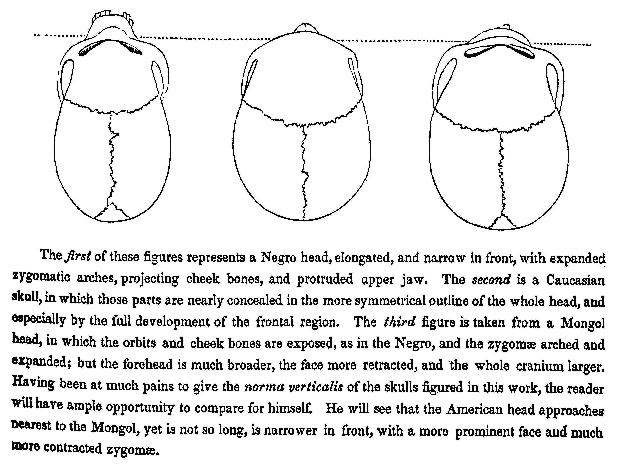
An 1839 drawing by Samuel George Morton of "a Negro head …, a Caucasian skull …, a Mongol head"
https://en.wikipedia.org/wiki/History_of_anthropometry
| Gibbons[1][2] Temporal range: Late Miocene–recent
| |
|---|---|
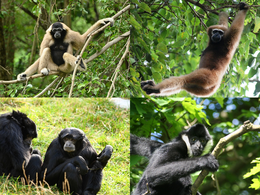
| |
| Gibbon species of different genera; from top-left, clockwise: Pileated gibbon (Hylobates pileatus), western hoolock gibbon (Hoolock hoolock), yellow-cheeked gibbon (Nomascus gabriellae), siamang (Symphalangus syndactylus) | |
| Scientific classification | |
| Kingdom: | Animalia |
| Phylum: | Chordata |
| Class: | Mammalia |
| Order: | Primates |
| Suborder: | Haplorhini |
| Infraorder: | Simiiformes |
| Parvorder: | Catarrhini |
| Superfamily: | Hominoidea |
| Family: | Hylobatidae Gray, 1870 |
| Type genus | |
| Hylobates Illiger, 1811
| |
| Genera | |

| |
| Distribution in Southeast Asia | |
Gibbons (/ˈɡɪbənz/) are apes in the family Hylobatidae (/ˌhaɪləˈbætɪdiː/). The family historically contained one genus, but now is split into four extant genera and 20 species. Gibbons live in subtropical and tropical rainforest from eastern Bangladesh to Northeast India to southern China and Indonesia (including the islands of Sumatra, Borneo and Java).
Also called the lesser apes, gibbons differ from great apes (bonobos, chimpanzees, gorillas, orangutans and humans) in being smaller, exhibiting low sexual dimorphism, and not making nests.[5] Like all apes, gibbons are tailless. Unlike most of the great apes, gibbons frequently form long-term pair bonds. Their primary mode of locomotion, brachiation, involves swinging from branch to branch for distances up to 15 m (50 ft), at speeds as fast as 55 km/h (34 mph). They can also make leaps up to 8 m (26 ft), and walk bipedally with their arms raised for balance. They are the fastest of all tree-dwelling, nonflying mammals.[6]
Depending on the species and sex, gibbons' fur coloration varies from dark- to light-brown shades, and any shade between black and white, though a completely "white" gibbon is rare.
https://en.wikipedia.org/wiki/Gibbon
Etymology
The English word "gibbon" is a reborrowing from French and may originally derive from an Orang Asli word.[7]
Evolutionary history
Whole genome molecular dating analyses indicate that the gibbon lineage diverged from that of great apes around 16.8 million years ago (Mya) (95% confidence interval: 15.9–17.6 Mya; given a divergence of 29 Mya from Old World monkeys).[8] Adaptive divergence associated with chromosomal rearrangements led to rapid radiation of the four genera 5–7 Mya. Each genus comprises a distinct, well-delineated lineage, but the sequence and timing of divergences among these genera has been hard to resolve, even with whole genome data, due to radiative speciations and extensive incomplete lineage sorting.[8][9] An analysis based on morphology suggests that the four genera are ordered as (Symphalangus, (Nomascus, (Hoolock, Hylobates))).[10]
| Hominoidea (hominoids, apes) |
| |||||||||||||||||||||||||||||||||||||||||||||||||||||||||||||
|
|
A coalescent-based species tree analysis of genome-scale datasets suggests a phylogeny for the four genera ordered as (Hylobates, (Nomascus, (Hoolock, Symphalangus))).[11]
| Hominoidea (hominoids, apes) |
| |||||||||||||||||||||||||||||||||||||||||||||||||||||||||||||
|
|
At the species level, estimates from mitochondrial DNA genome analyses suggest that Hylobates pileatus diverged from H. lar and H. agilis around 3.9 Mya, and H. lar and H. agilis separated around 3.3 Mya.[9] Whole genome analysis suggests divergence of H. pileatus from H. moloch 1.5–3.0 Mya.[8] The extinct Bunopithecus sericus is a gibbon or gibbon-like ape, which until recently, was thought to be closely related to the hoolock gibbons.[2]
https://en.wikipedia.org/wiki/Gibbon
| Southern white-cheeked gibbon[1] | |
|---|---|
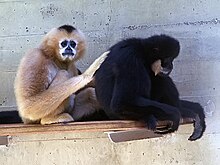
| |
| Female (left) and male | |
| Scientific classification | |
| Kingdom: | Animalia |
| Phylum: | Chordata |
| Class: | Mammalia |
| Order: | Primates |
| Suborder: | Haplorhini |
| Infraorder: | Simiiformes |
| Family: | Hylobatidae |
| Genus: | Nomascus |
| Species: | N. siki
|
| Binomial name | |
| Nomascus siki (Delacour, 1951)
| |

| |
| Southern white-cheeked gibbon range | |
The southern white-cheeked gibbon (Nomascus siki) is a species of gibbon native to Vietnam and Laos. It is closely related to the northern white-cheeked gibbon (Nomascus leucogenys) and the yellow-cheeked gibbon (Nomascus gabriellae); it has previously been identified as a subspecies of each of these.
https://en.wikipedia.org/wiki/Southern_white-cheeked_gibbon
| Silvery gibbon | |
|---|---|

| |
| A silvery gibbon foraging in a Ficus tree. Photograph taken in Mount Halimun Salak National Park | |
| Scientific classification | |
| Kingdom: | Animalia |
| Phylum: | Chordata |
| Class: | Mammalia |
| Order: | Primates |
| Suborder: | Haplorhini |
| Infraorder: | Simiiformes |
| Family: | Hylobatidae |
| Genus: | Hylobates |
| Species: | H. moloch[1]
|
| Binomial name | |
| Hylobates moloch[1] (Audebert, 1798)
| |

| |
| Silvery gibbon range | |
The silvery gibbon (Hylobates moloch), also known as the Javan gibbon, is a primate in the gibbon family Hylobatidae. It is endemic to the Indonesian island of Java, where it inhabits undisturbed rainforests up to an altitude of 2,450 m (8,040 ft). It is listed as Endangered on the IUCN Red List since 2008, as the wild population is estimated at comprising less than 2500 mature individuals.[2]
Its coat is bluish-grey in colour, with a dark grey or black cap. Like all gibbons, the silvery gibbon lacks an external tail, has dorsally placed scapulae, and reduced flexibility in its lumbar region. It has long, curved fingers and very long forelimbs relative to its hind limbs. On average, it reaches 8 kg (18 lb) in weight. It is diurnal and arboreal, climbing trees skilfully and brachiating through the forests. Brachiation is possible because of its mobile wrist joints, full rotation of the upper arm, and the ability to lock elbows in suspension. Its diet consists of fruits, leaves, and flowers.
Every three years, on average, the female gives birth to a single young, after a gestation of seven months. The offspring is nursed for about 18 months and lives with the family group until it is fully mature at about eight to ten years old.[3]
https://en.wikipedia.org/wiki/Silvery_gibbon
The agile gibbon (Hylobates agilis), also known as the black-handed gibbon, is an Old World primate in the gibbon family. It is found in Indonesia on the island of Sumatra, Malaysia, and southern Thailand. The species is listed as endangered on the IUCN Red List due to habitat destruction and the pet trade.
| Agile gibbon[1] | |
|---|---|

| |
| A male agile gibbon | |
| Scientific classification | |
| Kingdom: | Animalia |
| Phylum: | Chordata |
| Class: | Mammalia |
| Order: | Primates |
| Suborder: | Haplorhini |
| Infraorder: | Simiiformes |
| Family: | Hylobatidae |
| Genus: | Hylobates |
| Species: | H. agilis
|
| Binomial name | |
| Hylobates agilis F. Cuvier, 1821
| |

| |
| Agile gibbon range | |
| Synonyms | |
| |
https://en.wikipedia.org/wiki/Agile_gibbon
edia
| Müller's gibbon[1] | |
|---|---|
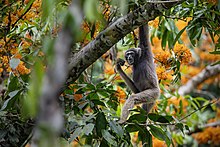
| |
| Scientific classification | |
| Kingdom: | Animalia |
| Phylum: | Chordata |
| Class: | Mammalia |
| Order: | Primates |
| Suborder: | Haplorhini |
| Infraorder: | Simiiformes |
| Family: | Hylobatidae |
| Genus: | Hylobates |
| Species: | H. muelleri
|
| Binomial name | |
| Hylobates muelleri Martin, 1841
| |
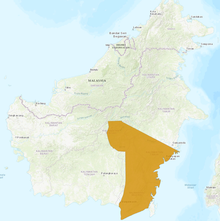
| |
| Müller's gibbon range | |
Müller's gibbon (Hylobates muelleri),[2] also known as the southern grey gibbon, is a primate in the gibbon family, Hylobatidae.
https://en.wikipedia.org/wiki/M%C3%BCller%27s_gibbon
| Northern white-cheeked gibbon | |
|---|---|
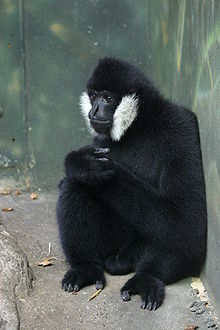
| |
| Male at Lincoln Park Zoo, Chicago, United States | |

| |
| Female at Adelaide Zoo, Australia | |
| Scientific classification | |
| Kingdom: | Animalia |
| Phylum: | Chordata |
| Class: | Mammalia |
| Order: | Primates |
| Suborder: | Haplorhini |
| Infraorder: | Simiiformes |
| Family: | Hylobatidae |
| Genus: | Nomascus |
| Species: | N. leucogenys
|
| Binomial name | |
| Nomascus leucogenys (Ogilby, 1840)
| |

| |
| Northern white-cheeked gibbon range (brown — extant, orange — probably extinct) | |
| Synonyms | |
|
Hylobates leucogenys (Ogilby, 1840) | |
The northern white-cheeked gibbon (Nomascus leucogenys) is a Critically Endangered species of gibbon native to South East Asia. It is closely related to the southern white-cheeked gibbon (Nomascus siki), with which it was previously considered conspecific.[3] The females of the two species are virtually indistinguishable in appearance.[4]
The genome of N. leucogenys was sequenced and published in 2011.[5]
https://en.wikipedia.org/wiki/Northern_white-cheeked_gibbon
https://en.wikipedia.org/wiki/Gibbon
Gibbons were the first apes to diverge from the common ancestor of humans and apes about 16.8 Mya. With a genome that has a 96% similarity to humans, the gibbon has a role as a bridge between Old World monkeys, such as macaques, and the great apes. According to a study that mapped synteny (genes occurring on the same chromosome) disruptions in the gibbon and human genome, humans and great apes are part of the same superfamily (Hominoidea) with gibbons. The karyotype of gibbons, however, diverged in a much more rapid fashion from the common hominoid ancestor than other apes.
The common ancestor of hominoids is shown to have a minimum of 24 major chromosomal rearrangements from the presumed gibbon ancestor's karyotype. Reaching the common gibbon ancestor's karyotype from today's various living species of gibbons will require up to 28 additional rearrangements. Adding up, this implies that at least 52 major chromosomal rearrangements are needed to compare the common hominoid ancestor to today's gibbons. No common specific sequence element in the independent rearrangements was found, while 46% of the gibbon-human synteny breakpoints occur in segmental duplication regions. This is an indication that these major differences in humans and gibbons could have had a common source of plasticity or change. Researchers view this unusually high rate of chromosomal rearrangement that is specific in small apes such as gibbons could potentially be due to factors that increase the rate of chromosomal breakage or factors that allow derivative chromosomes to be fixed in a homozygous state while mostly lost in other mammals.[31]
https://en.wikipedia.org/wiki/Gibbon




No comments:
Post a Comment